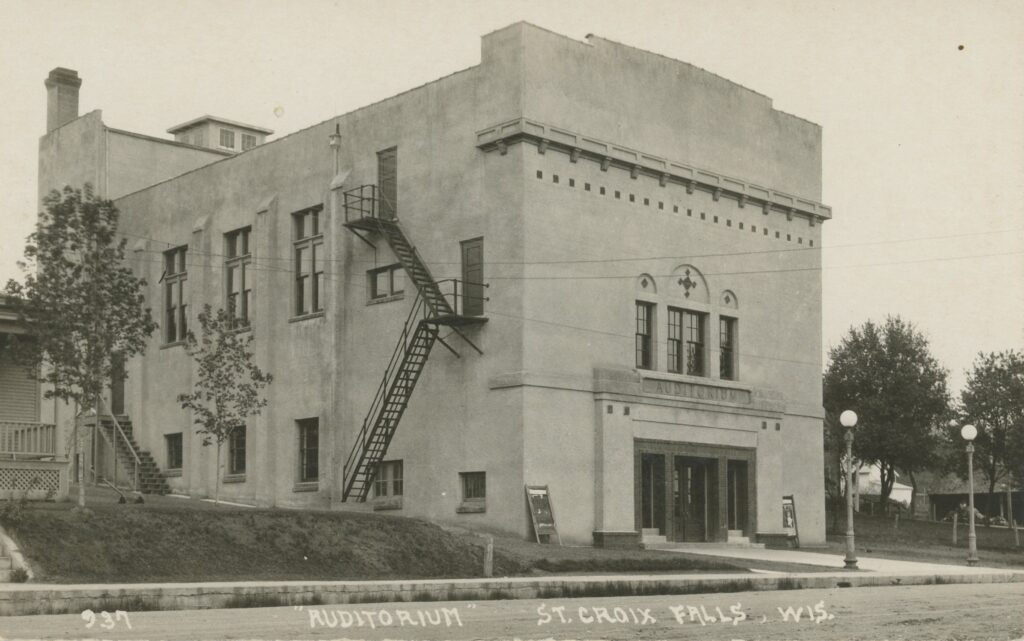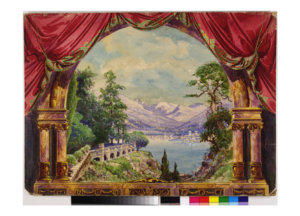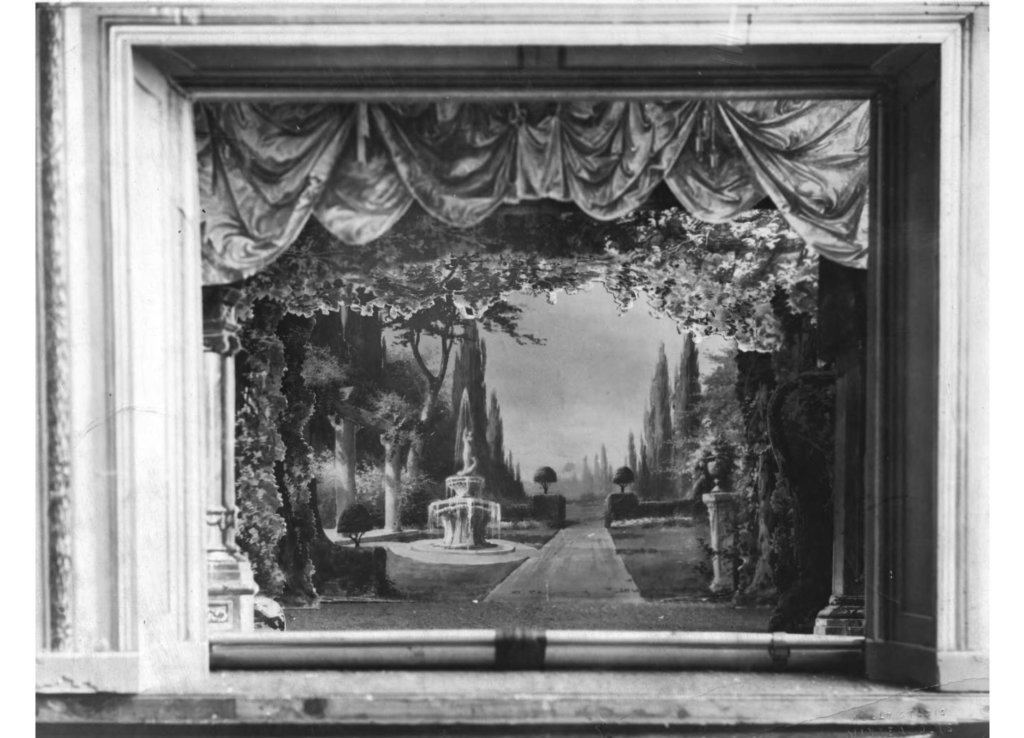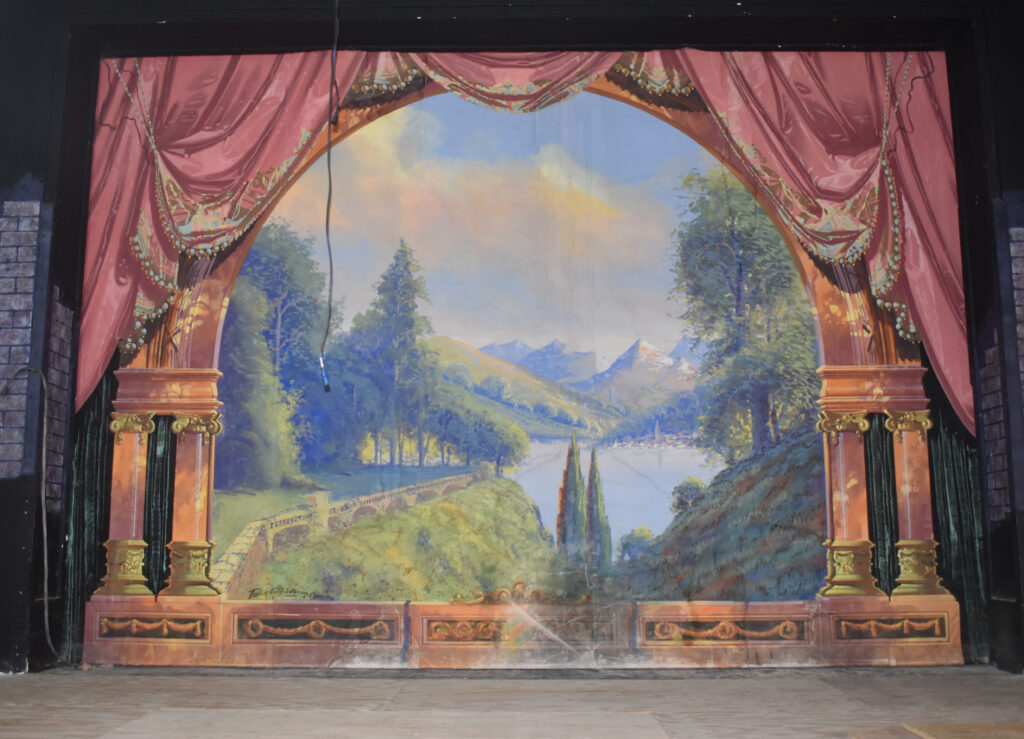
A postcard image of the Auditorium in St. Croix Falls in 1920. Photo courtesy of the St. Croix Falls Historical Society.
As I eagerly await the restoration and re-opening of our historic municipal Auditorium in St. Croix Falls, I am collecting stories and building a timeline of the Auditorium’s many uses over the years. Ironically, the Auditorium’s shortest-lived era was its intended purpose – a Vaudeville theater to attract traveling shows and spectators to St. Croix Falls during the early twentieth century before the popularity of film. At the time of the building’s construction in 1915, the St. Croix Falls Village Board understood the theater would need stock scenery as many traveling Vaudeville acts did not travel with set pieces. As a part of the cost of construction, the board commissioned stock scenery and a fire drop curtain from the Twin City Scenic Company (1895-1979) located on Nicollet Avenue in Minneapolis. The Twin City Scenic Company created stock scenery for theater companies, asbestos fire drop curtains for opera houses and auditoriums, and set pieces and advertisements for the Ringling Brothers Circus. Additionally, they created scenery for Masonic rituals, the Scottish Rite temples, Elks, and other fraternal organizations. They sold ready-made and custom options to a national audience, and everything they created was hand-rendered- even the paint was mixed by hand for each piece. The Twin City Scenic Company employed male artists to work in groups to complete these large-scale painting projects. Often, they would work from a sourced photograph of a palatial landscape and add architectural flourishes, such as marble columns, fabric swags, and imagined medieval walls – as you see in this original sketch of the fire drop curtain that remains in the Auditorium in St. Croix Falls today.

The original sketch for the drop curtain in the Auditorium, 1916. Photo courtesy of University of Minnesota Libraries.
The artists began each project with a watercolor sketch. Sketches intended to be sold as a ready-made option were then provided to the sales department. The showroom at the Twin City Theater company included lighting equipment, fabric drapery samples, and miniature models of stages wherein the sketches could be dropped in to give customers a realistic view of how the curtain or set piece might look in their theater. Salesmen would sometimes travel with the miniatures, which included working lines, to raise and lower the watercolor curtains into place to give the full effect. However, the company realized sending original watercolors with salesmen was not always feasible. Their solution was to take photographs of the original sketches and then have an artist colorize the black and white photo to make it easier to reproduce should an image be lost or left behind with a potential customer. They would also sometimes take photos of a completed and installed curtain, colorize them, and then bind them into sample books, including customer testimonials.

This is an example of a miniature theater model the Twin City Scenic Company utilized to sell set pieces and drop curtains. Photo courtesy of University of Minnesota Libraries.
Once a customer decided on the image, the salesman would provide stage measurements to the artists, and their selected image was translated into a full-scale set piece or curtain. Multiple artists would work on a drop curtain at once using a system of pulleys and scaffolding. In most instances, they would sketch, paint, and finish the piece in one or two days. Once the curtain was complete, it was rolled onto a basswood roller and shipped by train. Each curtain traveled with a stage carpenter and a scenic artist to install and paint any finishing touches.

The fire drop curtain in the St. Croix Falls auditorium prior to preservation efforts by Walter Lab.
The historic Auditorium’s fire drop curtain is a shining and extremely rare example of the Twin City Scenic Company’s work. Fortunately, it hangs in place over the stage today. Since the curtain’s installation in 1916, it has surprisingly suffered very little damage beyond water spots and tiny holes. Our community recently came together to raise funds for the preservation of the drop curtain. The Festival Theatre’s Technical Director, Walter Lab, and volunteers lightly repaired, cleaned, and encapsulated the asbestos curtain to ensure it could safely remain in the Auditorium for years to come. After an eight-year hiatus and a long overdue restoration of the entire building, many of us in St. Croix Falls are excited to see The Festival Theatre occupy this incredible space again and continue to be stewards of our city’s treasured history.
Sources
- The Twin City Scenic collection (PA043), Performing Arts Archives, University of Minnesota Libraries, Minneapolis, Minnesota. https://archives.lib.umn.edu/repositories/9/resources/1879 Accessed April 12, 2024.
- “Drapery and marble column framed town on a lake at the foot of the mountains..” University of Minnesota Libraries, Performing Arts Archives., Accessed April 12, 2024. https://umedia.lib.umn.edu/item/p16022coll116:1921

Recent Comments